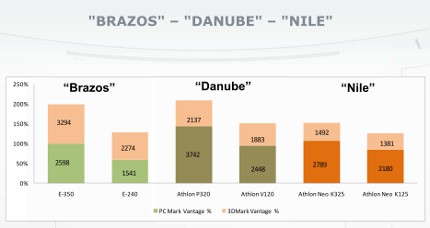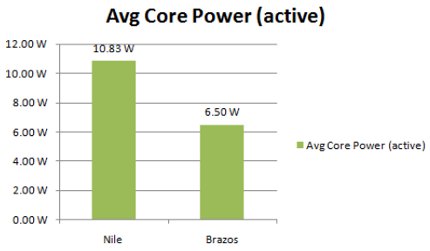We found out a lot more details about AMD's upcoming Fusion notebook chips last week after some journalists were allowed to see them first hand at the company's facility in Austin. Even though we learnt about the architecture, specific products and the Brazos platform, performance numbers were kept under wraps.
Now the covers have been pulled away and we can get an idea how the new chips perform, courtesy of some performance figures from AMD. The first tests compared some of the company's dual-core chips, and the 1.6GHz E-350 Zacate CPU performed about on par with a 2.1GHz Athlon II P320-based Danube system overall, though the newer chip was stronger in 3D Mark Vantage and weaker in PC Mark Vantage. It was a similar story with the 1.3GHz Athlon II Neo K325-based Nile system, with the newer chip trailing in the CPU intensive tests - though only by a hair - but excelling when GPU power was required.
The single-core chips were also put through the suite, and again the single-core E-240 trailed a 2.2GHz Athlon V120 and 1.7GHz Athlon II Neo K125 by an appreciable margin in CPU-heavy tests but came out on top in 3DMark Vantage.
So why is AMD showing off that its new chips are, in some cases, slower than those in its 2010 platforms? The key is power-draw. The Danube platform is designed for mainstream notebooks, and both of the CPUs have a TDP of 25W in addition to the draw for the Radeon HD 4220 GPU. The Nile chips are designed for ultraportables, but the processor alone still has a 12W TDP.
The thermal-envelope for the Brazos chips - including the on-die GPU, remember - is only 18W, so performance-per-watt should be much better than on the older platforms. This should greatly improve the battery-life and decrease the amount of heat generated, both of which were issues for Nile and Danube systems.
AMD put this into practice by measuring power-draw while running through 3DMark06. The results speak for themselves, with the Brazos platform's averaging 'active' power-draw of only 6.5W - 40 per cent less than the ultraportable Nile platform's 10.83W. 'Passive' draw measured during MobileMark2007 is similarly impressive, measuring 2.71W compared to the Nile platform's 4.14W.
Based on what AMD has shown, the dual-core APUs could be a force to be reckoned with in the ultraportable space, although we'll reserve judgements until we can compare the platform to Intel's current and next-generation alternatives. The single-core chip seems a little lacklustre in terms of CPU performance, although the V120 to which it was compared was certainly no slouch. And remember, the added graphical-oomph will give the chips a huge leg-up over the competition.















